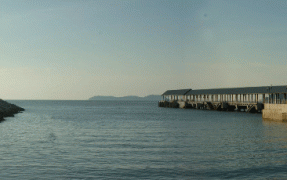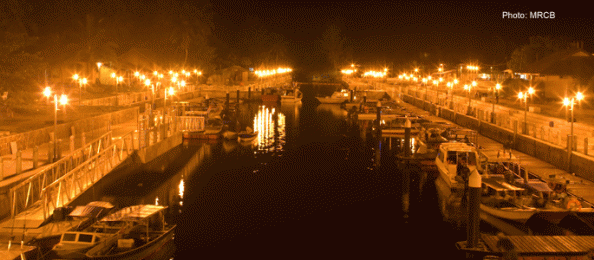The Pulau Tioman Project
Malaysian Resources Corporation Berhad (MRCB) is a leading urban property and infrastructure developer. The Group specializes in civil, environmental, and energy infrastructure, including beach rehabilitation projects, road works, road concessions, educational colleges, hospitals, and power plants. It is also the nation’s biggest developer of high-voltage transmission networks.
Pulau Tioman (Tioman Island) is a world-renowned tourist destination famed for its breathtaking, scenic spots, crystal clear waters, and white sandy beaches. Lying some 56 km off the coast of Pahang State, Pulau Tioman is about 38 km in length and 19 km at its widest point, with its main center at Kampung Tekek – one of the nine idyllic villages on the island.
With tourism as its main source of income, its success as a major tourist center directly threatens this income. Unchecked erosion caused by increasing environmental pressures from the growing number of visitors and expanded development has damaged its coastline, beaches, and rivers. This includes development of private properties as well as public infrastructure. The erosion has already damaged the biodiversity of the island and contributed to the loss of sandy beaches as the shoreline has retreated inland. Chalets in the northern end of Teluk Tekek, Tioman Island, have also suffered loss of business as the sandy beach frontage has been transformed into a rocky shoreline due to the loss of sand.
Realizing the urgent need to rehabilitate and preserve Kampung Tekek’s pristine coastline and biodiversity, the Malaysia government – through its agency Jabatan Pengairan dan Saliran (JPS) – has initiated the rehabilitation project. JPS has engaged and appointed MRCB Environment Sdn Bhd (MESB), a subsidiary of MRCB, to design, construct, and rehabilitate the coastline using MRCB’s proprietary Pressure Equalization Module (PEM) system. Recognizing the sensitivity of the location in terms of biodiversity and its remoteness to sources for supplies, MRCB developed a holistic approach in ensuring minimal impacts in restoring and conserving threatened biodiversity. At the same time, the process maintains the existing naturally-occurring ecosystem, communities, and native species.
Construction stages
With this perspective in mind, the entire project was studied in detail to ensure that precise management and handling took place to minimize damages to the surrounding environments. A detailed impact-analysis was carried out during pre-construction of the project involving impacts on aquatic life and coral, soil, marine water, drainage and flooding, noise, air, the local business and resident communities. Environmental training was provided at the start of the project to brief all parties involved in the project on the environmental awareness at the project site. The training covered the specially designed Environmental Management Plan (EMP) and best management practice on site, and involved participants from all relevant JPS staff, site supervision staff from MRCB, and all senior site staff of the sub-contractors.
During the construction stages, the EMP was prepared and put in place by an environmental consultant to address potentially significant environmental impacts that may arise during construction. All materials were sourced from outside the island so that the ecosystem of the environment on the island was not disturbed. A thorough Environmental Impact Study was carried out and included a detailed mapping of the coral habitat in and around the rehabilitated areas. Anti-pollution measures were strictly enforced to control pollutants from entering into the sensitive marine ecology. Double-layered silt curtains were installed prior to every work task to ensure no sedimentation or construction debris flowed out to the sea or had a major impact on the coral nearby. No work could start until the silt curtains were checked every morning and confirmed to be in working condition. If there was a tear, work would stop immediately and maintenance was quickly conducted to reduce the impact of sedimentation.

Apart from the above, barges carrying construction materials landed only during high tide and had to follow the approved route to ensure no coral was damaged in the process of landing. MRCB also conducted an environmental awareness campaign on the island to highlight the importance of cleanliness, recycling, and environmental preservation.
With the completion of the project, MRCB instituted a rigid system of evaluation and monitoring to ensure the bio-system of the marine ecosystem returned to its normal state and flourished with the improved bio-system. A detailed monitoring system is in place to examine the physical environment as well as the biological and socioeconomic impacts on Teluk Tekek in Tioman Island. The study includes research on the physical environment, the hydraulic circulation, coastal evolution, river mouth, as well as water quality, drainage, and flooding. The biological aspects of the monitoring include coral, aquatic species, macro-invertebrate, macro-benthos, and plankton ecosystems. The socioeconomic aspects include the community and the tourism industry as well as areas for improvement concerning lifestyles, better business prospects, improved tourism, better infrastructure/ mooring facilities, and navigation for the fishermen. MRCB found that all aspects mentioned have improved significantly.
Impact on community
Villagers were affected by the ongoing construction activity as it disrupted their tourism activities. However, since the completion of the project, the village has been transformed into a tourist haven with more tourist facilities such as a wider main road, a modern jetty with walkway, lighted gardens, and modern, convenient cafes.
For the fishing community, the main advantage is the availability of 24-hour navigation for all the boats as well as for those involved in tourism boat activities due to the successful rehabilitation of Sg. Tekek and Sg. Batang Sabut. Before the project commenced, the river mouths were not accessible for several months each year, which impeded valuable earnings for the villagers.
Like the villagers, the tourists will find a new, comfortable, and convenient tourist location at Kampung Tekek with all new and modern facilities. The availability of systematic boat berthing will improve the convenience and facilitate a comfortable arrival for tourists while other new “tourist” facilities such as the modern jetty, lighted gardens, and modern cafes only add more convenience and comfort for tourists coming to the island.
Tourism for local community and nation
Since tourism is the main economic activity of Kampung Tekek, the project design took into account the coral and marine communities, which were the main aspect and attraction for the island. Due to the sensitivity of one 700-meter stretch, a beach nourishment method was evaluated but later omitted from the plan because of the high density of healthy coral growing on the nearby shore. Huge efforts were taken in the installation and maintenance of the silt curtain concerning tidal fluctuation effects at the river mouth and beach area during construction to ensure the work would not damage the coral and marine life, which, as a main tourist attraction, is the main source of economy for the local community.
This project description was originally presented in the Global Compact International Yearbook 2010.
About Us // Privacy Policy // Copyright Information // Legal Disclaimer // Contact
Copyright © 2012-2018 macondo publishing GmbH. All rights reserved.
The CSR Academy is an independent learning platform of the macondo publishing group.









